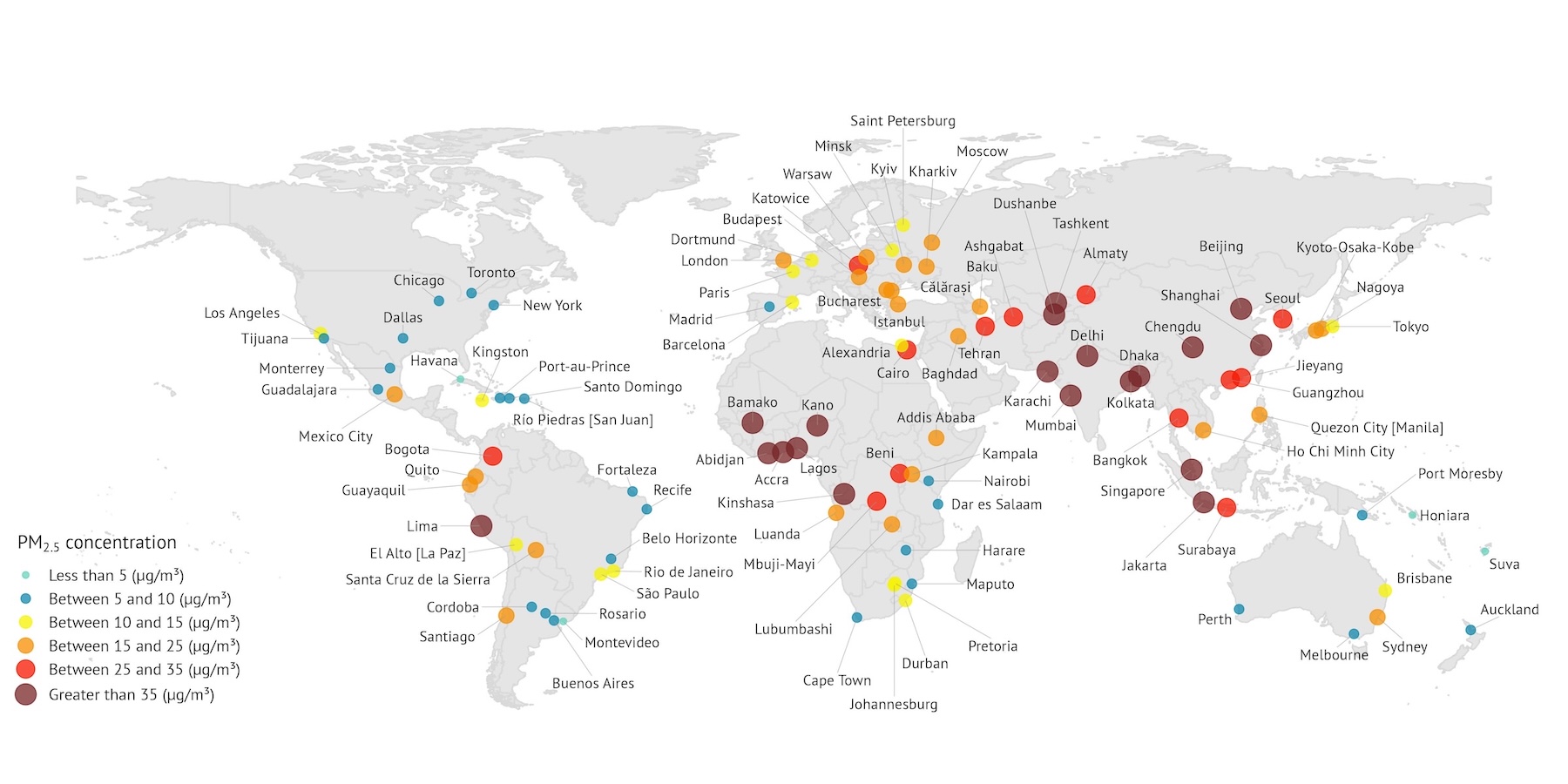Air Quality
Compiled by: Yan Vana
Introduction
With more people comes more waste, contamination, pollution, and other issues detrimental to human heath and the health of the planet’s ecosystems. Of all the threats to human health, poor air quality is probably the most directly affecting.
Human population growth and declining air quality across the globe are directly inter-connected. According to the World Health Organization (WHO) 99 per cent of human beings currently breathe air that exceeds the WHO’s guideline limits for pollutants, with those living in low- and middle-income countries suffering the most.
Currently, an estimated 7 million people die prematurely each year as a direct result of air pollution.

Key Facts
Causes of poor air quality.
Air pollution is a mix of hazardous substances from both human-made and natural sources. According to the Natural Resources Defense Council (NRDC), most air pollution comes from energy use and production, and is intrinsically bound to human population density.[1]
The primary causes of poor air quality are as follows.
Burning fossil fuels: The biggest contributors of air pollution are from industry sources and power plants, as well as fossil fuel motor vehicles. The continuous burning of fossil fuels releases air pollutants, emissions and chemicals into the air and atmosphere.
Ozone and smog: Ozone is a gas that, when it forms air pollution and reaches too close to the ground, it significantly reduces visibility. We call this smog. This form of air pollution occurs when sunlight reacts with nitrogen oxides released from car exhausts and coal power plants. The ozone typically forms a protective layer in the atmosphere to protect the planet from ultraviolet radiation (UV), but as it transforms into smog, it is harmful to human health and poses higher risks of respiratory illnesses like asthma and lung cancer.[2]
Weather conditions: Air pollution and poor air quality can be attributed to changing weather conditions. For example, dust storms in China can carry clouds of industrial pollutants and particulate pollution across the Gobi desert into neighbouring countries such as Korea and Japan during spring season. Likewise, during periods of high air pressure, air becomes stagnant and pollutants are more concentrated over certain areas.[3]
Heatwaves and wildfires: Heatwaves not only lead to an increase of temperature, but can also cause air pollution. Hotter, stagnant air during a heat wave increases the concentration of particle pollutants. Extreme heat wave events also present a higher risk of large-scale wildfires which, in turn, release more carbon emissions, smog and pollutants into the air.
Air quality is closely linked to the Earth’s climate and ecosystems globally. Many of the drivers of air pollution, such as the burning of fossil fuels, are also sources of greenhouse gas emissions which accelerate climate change.

Poor air quality and human health.
Poor air quality, or air pollution, generally refers to substances in the air that are detrimental to either human health and/or the planet as a whole. At significant levels, all types of air pollution pose a risk to those exposed to it, increasing the likelihood of adverse health effects.
In 2019, the World Health Organization (WHO) deemed air pollution to be the greatest environmental health risk, contributing to an estimated 7 million premature deaths annually. Among children under the age of 15, it is the leading cause of death, killing 600,000 every year.[4]
Air pollution is described as a ‘silent killer’ because it is rarely a direct cause of death. According to the WHO, it is the world’s 4th leading contributing cause of early death, accounting for:
-
29 per cent of all deaths and disease from lung cancer
-
17 per cent of all deaths and disease from acute lower respiratory infection
-
25 per cent of all deaths and disease from coronary heart disease
-
43 per cent of all deaths and disease from chronic obstructive pulmonary disease
-
24 per cent of all deaths from stroke
IQAir’s 2024 World Air Quality Report found that 91% out of 138 countries and regions around the globe exceeded the WHO annual PM2.5 guideline value of 5 µg/m3, with Central & South Asia home to cities with the poorest air quality in the world.[5]
The short-term health effects of poor air quality include difficulty breathing, chest pain, wheezing, coughing, general respiratory discomfort, and irritation of the eyes, nose and throat.
Long-term effects include lung tissue damage, cancer, early death, and the development of respiratory illnesses such as asthma, bronchitis and emphysema.
Regions with the poorest air quality.
Almost all people living in large cities are exposed to poor air quality.
Exposure to air pollution is highest in populous cities located in South Asia, East Asia, Southeast Asia, West Sub-Saharan Africa, and Andean and Central Latin America.
In particular, the cities of Beirut (Lebanon), Shenyang (China), Shanghai (China), and Moscow (Russia) – collectively home to over 53 million people[6] — have pollution levels that exceed even the highest WHO guideline thresholds.
The following infographic shows the population-weighted annual average pollutant concentrations of PM2.5 in the five most populous cities in each region (PM2.5 comes primarily from vehicle emissions, coal-burning power plants, industrial emissions).[7]
Source: State of Global Air (SoGA).
Additional Facts
Children under the age of 14 are one of the demographic groups most susceptible to severe adverse health effects from air pollution.[4]
Thousands of tons of microplastics are floating around the world. It’s estimated that most people could be inhaling up to 16.2 bits of plastic from clothing and plastic containers every hour. That’s the equivalent of a credit card every week.[8]
An estimated 44,000 new coal-fired power plants were completed and commissioned in 2024.[9]
Data Sources
[1] Natural Resources Defense Council (NRDC)
[2] Earth.Org – Causes and Effects of Air Pollution
[3] UCAR Center for Science Education – How Weather Affects Air Quality
[4] IQAir – Air Quality in the World
[5] IQAir – 2024 World Air Quality Report
[7] State of Global Air – Air Pollution and Health in Cities



